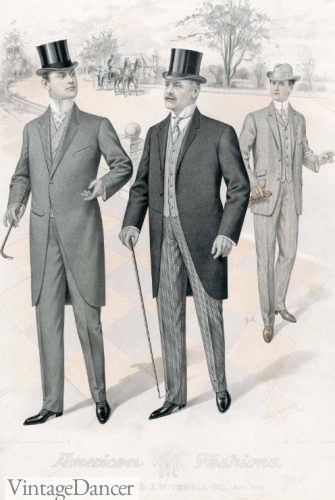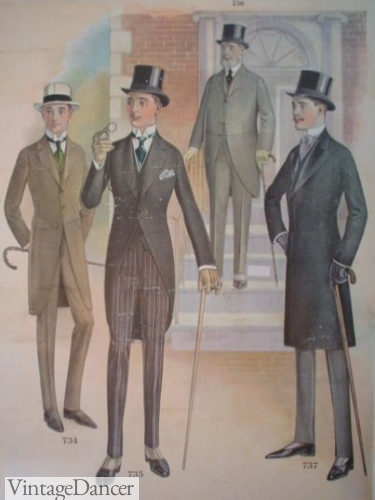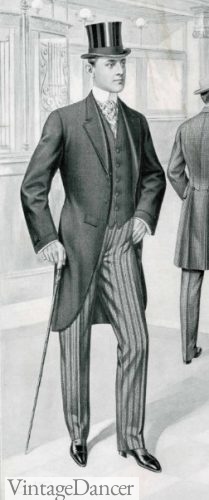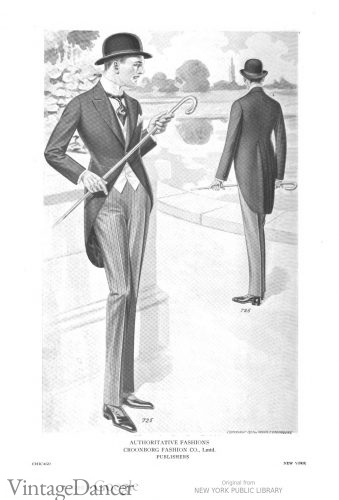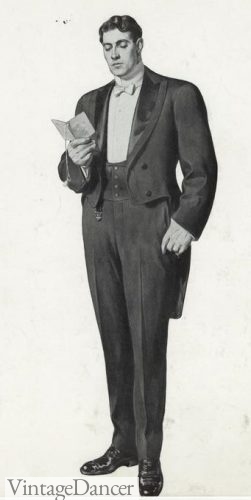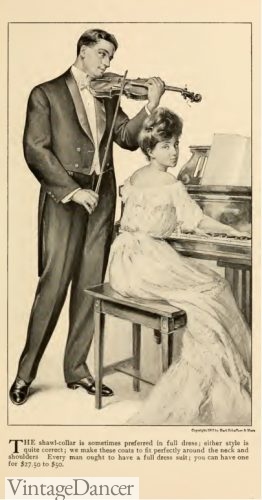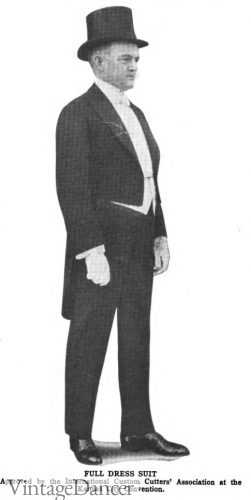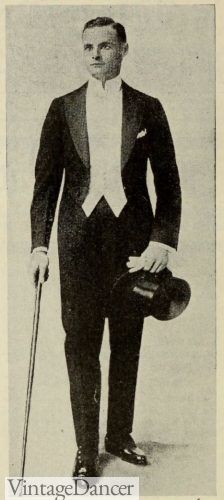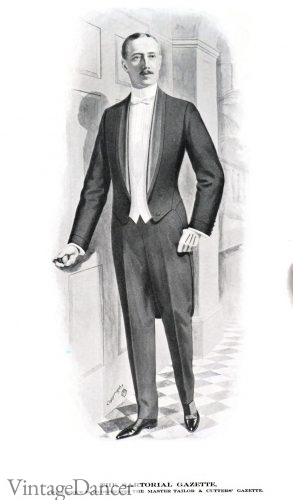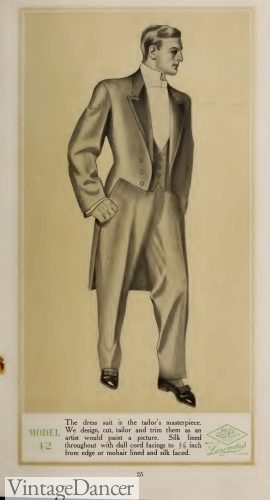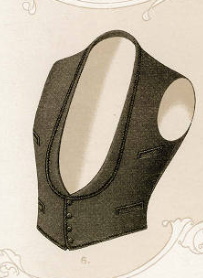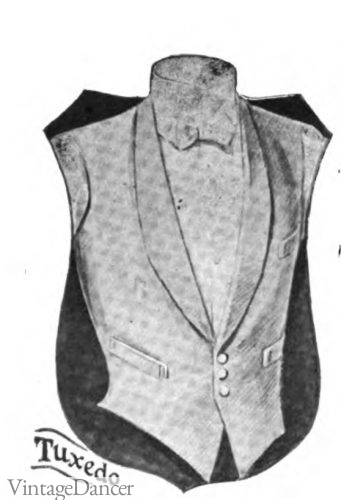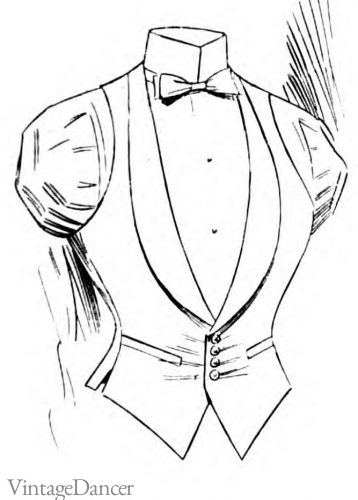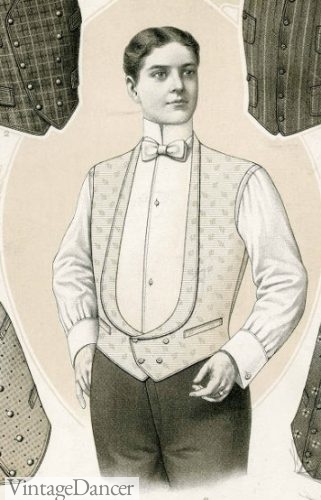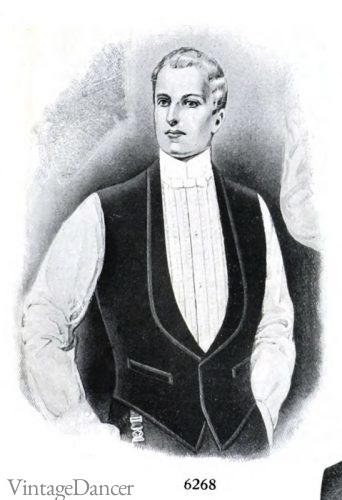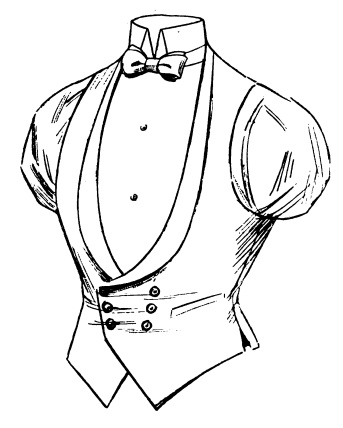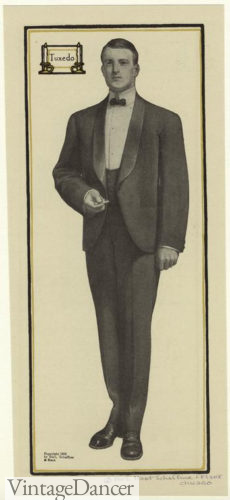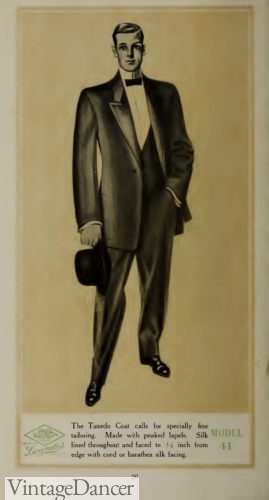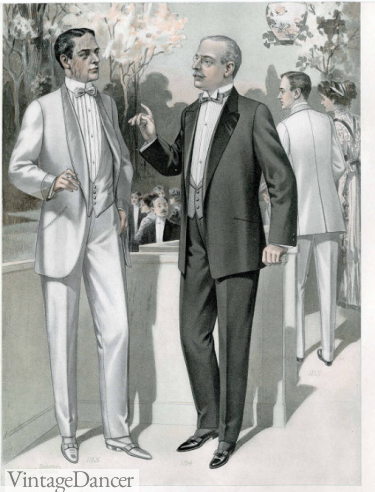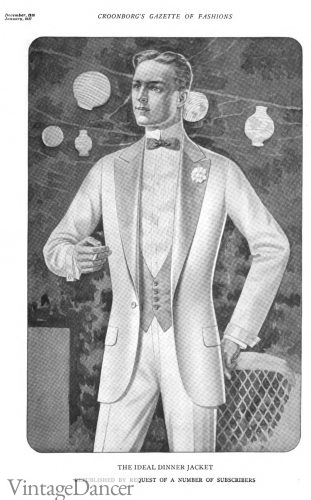First-class men and women dressed up nightly for formal dinners on the Titanic. Gentlemen attending an Edwardian era (1900-1910s) or 1912 Titanic themed evening event will want to don their best for the night out. Here is a guide on how to dress men for an Edwardian evening affair.
Men’s Edwardian formalwear consisted of a few key styles: the morning suit, the full dress tuxedo and the dinner jacket. Over the years, the shape of these formal suits followed fashion trends in daytime suiting, but never evolved into anything new.
For less formal options, read this article on or Edwardian 1900s men’s suits and 1910s Edwardian men’s fashion.
Cutaway Coat – Morning Suit
Cutaway coats (frock coats) were a suit dress option worn in the daytime for a business meeting, morning wedding, or sporting event like horseraces. Cutaway coats featured long rounded jacket fronts with single button closure that hung to the knee. They buttoned with a coat link or jacket button.
Lapels were faced in a matching dull silk. The shoulders were padded and arms full in the 1900s for a masculine Edwardian shape. As the decade moved into the Jazz fit, cutaways slimmed down all around for a tall, lean, and leggy look.
- 1904 morning suit (R) and cutaway formal suit (L)
- 1916 cutaway and morning suits
Cutaway coats (black or grey) worn as semi-dress were called morning suits when worn with worsted wool or cashmere striped grey and black trousers. Some older men wore black and white checked trousers called “sponge bags.”
- 1901 traditional grey striped morning trousers
- 1909 morning suit with dark vest
- 1917 morning suit in a very slim fit with white vest
A black double breasted Prince Albert coat or single breasted chesterfield coat (with velvet collar) was worn on top the of entire ensemble for cold weather. Unlike other outerwear coats, formalwear coats were well fitted to the body.
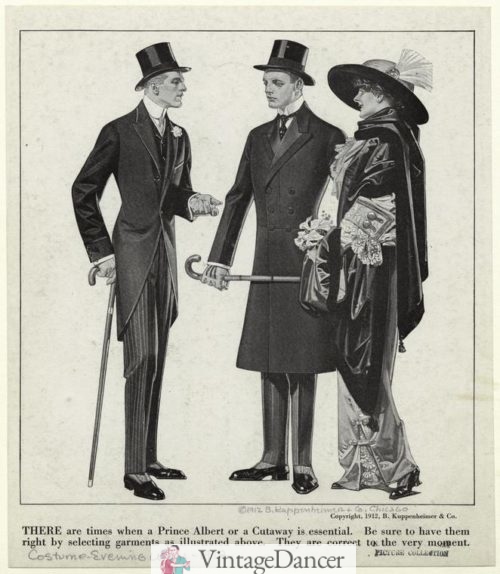
1912 morning suits and prince Albert overcoat
A single or double breasted waistcoat (vest) is worn with the suit. It could be any fashionable silk color he likes, light or dark, and could have or not have a collar and lapels. The freedom of the outfit was found in the vest and necktie, whereas everything else was predestined.
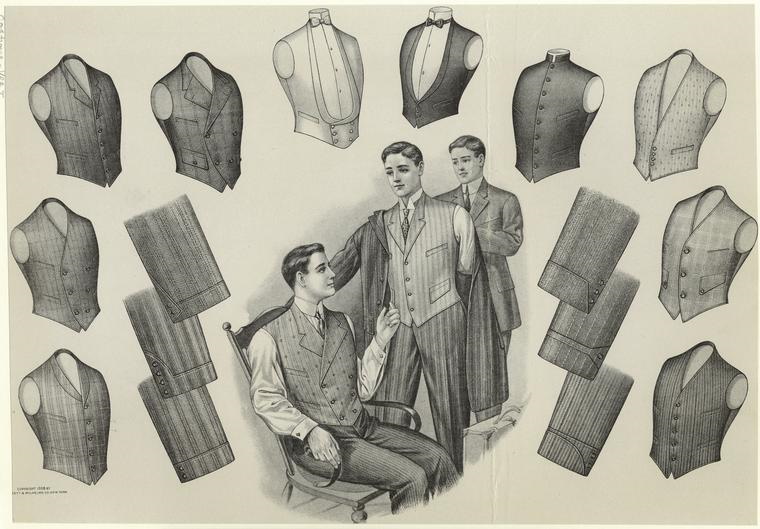
1908 men’s waistcoats and jacket cuffs (the top center two waistcoats are for formalwear, not morning suits.)
A tall wingtip collar white shirt or high-band poke collar shirt was worn underneath the vest. The phase “to get shirty” meant an angry man, because buttoned up a dress shirt with a tall stiff collar was a man’s most irritating moment of the day.
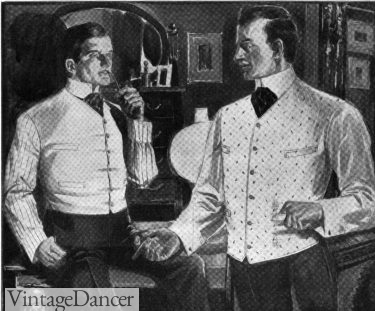
1903 plain and dot white vests with poke collar shirts and ascot ties
Neckties could be four-in-hand or ascot styles in any color that did not clash with the waistcoat. A nice tie pin held the ascot or tie to the shirt. For weddings, a grey waistcoat could be worn with a grey or white tie but a light waistcoat could only be worn with a dark grey tie, never white.
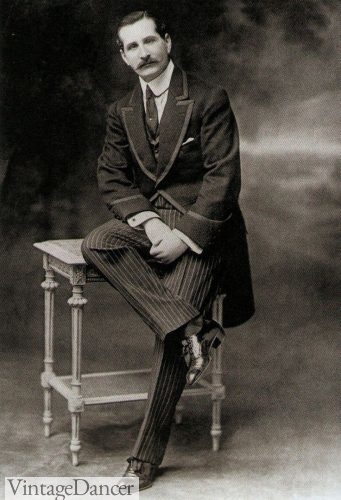
Early 1900s four in hand tie with morning suit
Shoes were lace-up patent leather boots in black or two-tone spat-top white-over-black boots. Grey or white shoe spats could also be worn over boots or low Oxford shoes.
A high silk top hat is the most traditional. A few young men began wearing bowler/derby hats with morning suits at the end of the era, but not for weddings.
Grey suede or buskin gloves were worn for daywear as well as weddings.
A white pocket square can be tucked into the jacket chest pocket. Add a walking stick or cane for full effect.
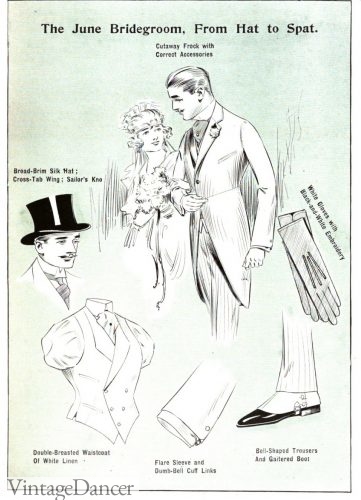
1917 spring wedding attire: morning coat, black silk top hat, white linen vest, white spats, white gloves with black embroidery, ascot or four in hand tie with sailors knot, dumb bell cuff links
To purchase morning suits and accessories, look here for online options. To rent a suit, contact your nearest rental house and ask if they have morning suits or cutaway coats. The Men’s Warehouse has cutaways to rent in the USA.
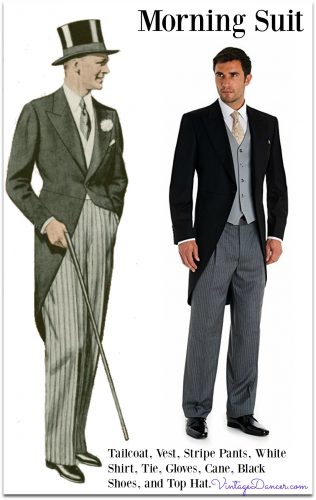
Classic morning suit of tailcoat, striped pants, double breasted vest, club or wingtip collar white shirt, white gloves, cane, lace up dress boots, tie, and silk top hat.
Edwardian Full Dress or White Tie
For very formal evening occasions such as large public gathering, balls, opera, and dinner parties men were required to dress in “full dress,” or what we now call “white tie.”
Gentlemen’s ‘White Tie’ formal wear consisted of a black tailcoat jacket with matching trousers, a white waistcoat, black silk top hat, black patent shoes, and a white bow tie. Unlike modern suits, the wool fabric was very thick and heavy. This kept the shape very stiff and fitted, meeting social requirements for pomp sophistication. The fit, however, was roomier in the arms and shoulders compared to the Victorian era.
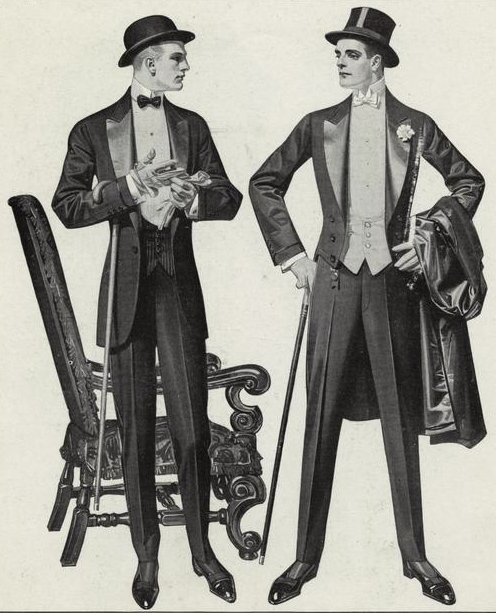
1912 tuxedo and full dress
- 1900 full dress
- 1905 full dress
- 1916 full dress
- 1919 full dress
The cut of the tailcoat was fitted to the body, emphasizing a waistline at the jacket edge. Special undergarments helped shape a man’s belly much like corsets did for women. Shoulderpads were also added to enhance the masculine shape.
The tailcoat jacket came in both peak and roll collar (shawl collar) lapels. The edge of the jacket bottom pointed downward rather than straight across. Although the jacket never buttoned closed, there were three buttons placed on each side of the jacket opening for decoration.
- 1910 full dress with roll collar lapels
- 1910 full dress with peak lapels
Matching black wool weight trousers sat high on the waist (above belly button level) and tapered down to the top of the ankle. Pockets were not necessary for formal wear and were usually left out. There was a sharp pressed crease down both the front and back of the pant legs. Sometimes, a single braid ran down the outer leg seam.
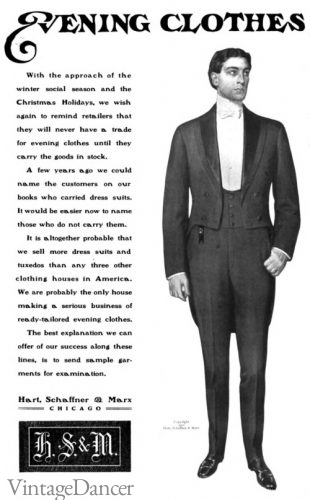
1900 full dress
Formal shirts were starched white bib-front button down dress shirts, with a detachable high stand collar. Softer pleated front shirts were a less common option, and usually considered too informal and “sloppy” until the end of the decade. Mother of pearl, white enamel, or gold shirt links and cuff links were the only jewelry found in formalwear.
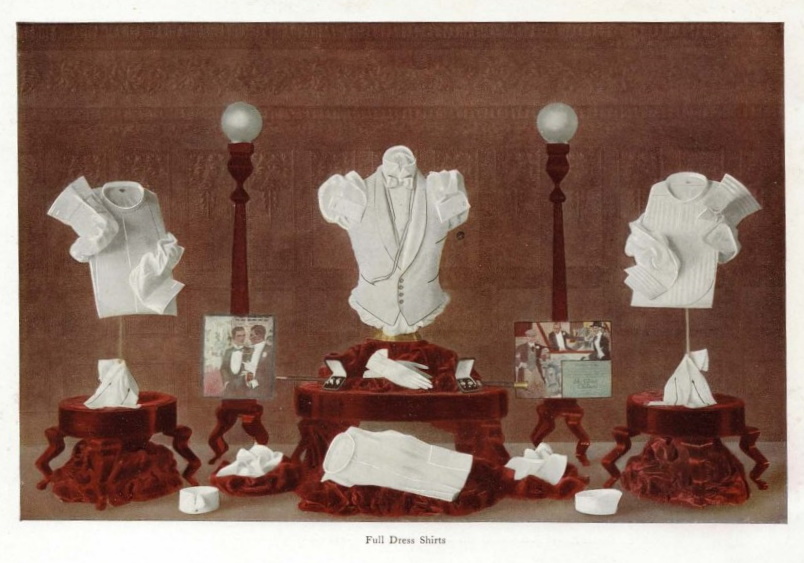
1915 formal shirts and waistcoats
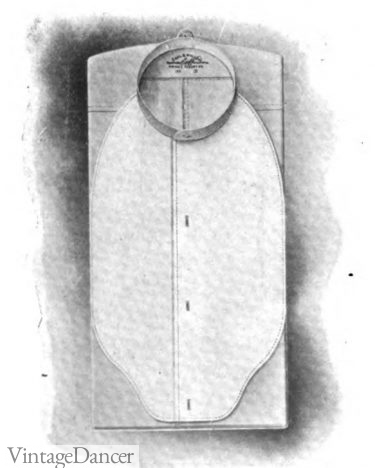
1907 bib front tuxedo shirt
The formal waistcoat (vest) could be made of black cloth or white pique. White was the most formal and safest option for any evening activity. Black could be worn to semi-formal dinner’s and evening events in close company of friends.
Unlike daytime vests, the evening waistcoat was cut in a wide and deep V with rounded roll edges and 4 buttons in a single breasted cut. The V looks more U in the early years and more V shaped by the mid 1900s. The newest style change was the addition of two sharp points that extended over the trousers.
- 1900 black waistcoat
- 1907 white vest
- 1919 white waistcoat
The double breasted waistcoat was an alternative for young men and dandies. Velvet waistcoat trended around 1910, also for the young and fashionable.
- 1900 white pique waistcoat
- 1910 velvet waistcoat
- 1917 white double breasted waistcoat
Formal shoes were lace-up patent leather Oxfords or slip on pumps with a bow.
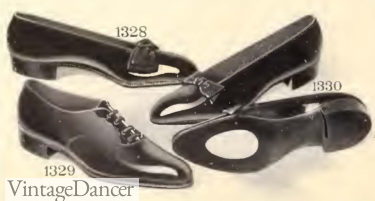
1914 men’s evening pumps and dancing oxfords
A high silk top hat was the only choice for evenings.
White gloves with a button at the wrist are the most formal.
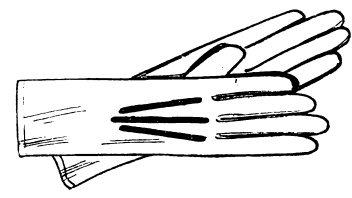
1917 white formal gloves
Dinner Jackets or Tuxedo Coats
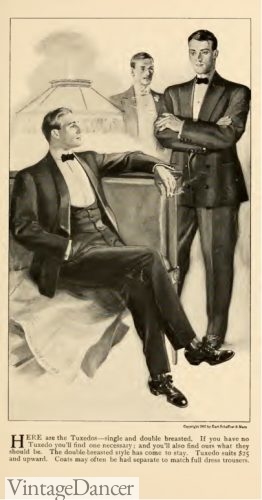
1907 men’s single and double breasted tuxedos
The third coat option for formal/semi-formal occasions is the Dinner Jacket, or its similar modern cousin the Tuxedo jacket (American name). They were worn for most dressy occasions that didn’t require very formal etiquette: the theater, music halls, stag parties, small dinner parties, dining out with close friends, etc. They were less welcome at the ballroom or ceremonial events, although these rules had to be relaxed after World War I.
- 1902 tuxedo suit
- 1910 tuxedo suit
The 1900-1910s tuxedo coat is a formal black sack coat with either a wide and rounded roll / shawl collar or a pointed peak lapel with a straight edge or slightly rounded edge down to the waistband. Usually, the collar was faced in matching smooth silk or with various textures such as basketweave, stripes, or diagonal ribbing. The skirt of the tuxedo jacket hung down to mid-thigh.
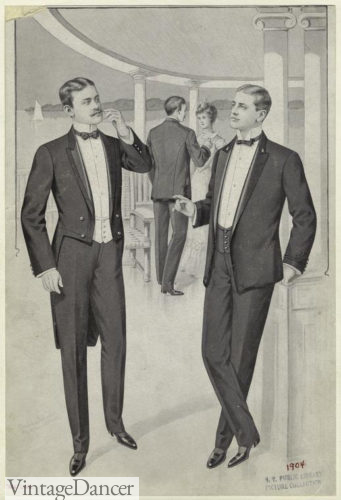
1904 tailcoat and dinner jacket suits
Unlike tailcoats, the tuxedo jacket could be worn with white, black, or slate grey formal waistcoats — single- or double-breasted — and black or white bow ties.
Edwardian Dandies wore double-breasted medium grey or dark blue coats and trousers instead of traditional black.
In summer, in tropical climates, men may have worn an all white dinner jacket. It was acceptable at seaside resorts where fashion tended to be informal already. A formal event would have men back in full black dress.
- 1910 black or white dinner jackets
- 1916 white dinner jacket, trousers and grey waistcoat
Edwardian Men’s Evening Accessories
Cufflinks
The standard cufflink for Edwardian formal occasion was an inlaid pearl. Mother of pearl, white linen, white enamel, and pearl link gems called Moonstone were also common. Gold or gold plated brass were more common for day wear, but could be worn in evenings. Both round and square shape cufflinks existed. You will need a French cuff or double cuff shirt to wear cufflinks. Shop men’s accessories here.
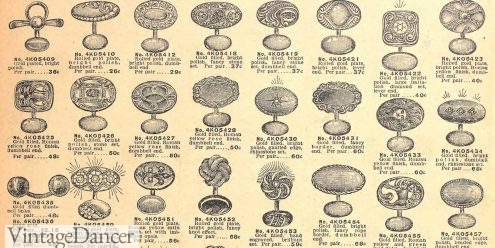
1908 gold plated round, oval or unusual shape cuff links
Pocket Square
The final touch on your formal suit is the white pocket square. This is not to be used as your handkerchief. Pocket squares were for decoration only. They were folded into a triangle and placed inside the front heart pocket with the pointy end facing up. Usually, they were made of silk.
Buy Men’s Tuxedos
Do you want to rent or buy? Most men will want to rent an entire tuxedo or morning suit for a one time event. To rent a suit contact you nearest rental house (men’s suit departments stores, wedding shops) and ask if they have what you need. The Men’s Warehouse some classic suits to rent in the USA. Buying accessories separately will give you more authentic shapes and colors then going with the pre-picked outfits.
To buy online: These new tuxedo, tailcoats, cutaway coats, dress shirts, vests, shoes and accessories are close enough to the Edwardian era for most evening events and weddings: Men’s Formal Wear.
Give yourself plenty of time (a month, not a week) to gather the pieces and have any alterations done.
To buy in store any rental shop will be able to order a suit for you. Some options are:
Dobell (USA) and Dobell.co.uk – Affordable tuxedos, suits and accessories. Not the highest quality but will be fine for a few events.
Men’s Warehouse – Buy online, classic or modern fit tuxedos. Jos A Bank will also have the same selection.
Brooks Brothers – Very high quality tuxedos, vest, bowties and accessories.
Debbie Sessions has been teaching fashion history and helping people dress for vintage themed events since 2009. She has turned a hobby into VintageDancer.com with hundreds of well researched articles and hand picked links to vintage inspired clothing online. She aims to make dressing accurately (or not) an affordable option for all. Oh, and she dances too.
